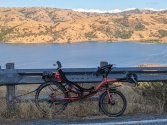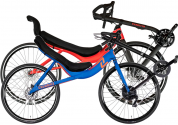David Saxton
New Member
I'm currently riding an HPV Speedmachine recumbent and am a pretty avid rider - I mostly ride for commuting on the flats, where that bike is ideal, and did ~4,000 miles / 100,000 ft of climbing on that bike in the past year.
I've been getting into longer road rides and am thinking of getting a new recumbent that climbs steep hills better than my heavy Speedmachine. I'm interested in the S40, since Cruzbikes seem fairly lightweight and also I like the large wheels plus lower foot position that the MBB system offers. The other "sporty" recumbent bikes I've looked at either give you a small front wheel or your feet end up pretty far above your hips, which I think is not as good for circulation. I have a bit of rise from seat to BB on my Speedmachine (pic below) - maybe 6 inches? - and I do currently experience some foot numbness on long climbs. My 20 inch front wheel on the Speedmachine works OK w/ it's suspension fork, but you really every bump on those smaller wheels. I don't think I would feel confident bombing down a steep descent at 45mph with an unsuspended 20" wheel.
The one weakness people have pointed out for the Cruzbikes is front wheel slippage / loss of traction on climbs. I want a new bike specifically to be able to conquer 10%+ grade hills, which are very common here in the SF Bay area. If you're a Cruzbike rider, what's your experience with this? When does slippage happen, and is there anything you can do about it (like run a larger or more supple front tire)?
I'm also curious if anyone has observed if the seat angle of the various Cruzbike models (20 vs 40 vs 45) has much impact on wheel slippage? My take on this would be that a higher seat angle might push the rider weight forward a bit and help traction on the front wheel?
Thank you for sharing your experience,
David
I've been getting into longer road rides and am thinking of getting a new recumbent that climbs steep hills better than my heavy Speedmachine. I'm interested in the S40, since Cruzbikes seem fairly lightweight and also I like the large wheels plus lower foot position that the MBB system offers. The other "sporty" recumbent bikes I've looked at either give you a small front wheel or your feet end up pretty far above your hips, which I think is not as good for circulation. I have a bit of rise from seat to BB on my Speedmachine (pic below) - maybe 6 inches? - and I do currently experience some foot numbness on long climbs. My 20 inch front wheel on the Speedmachine works OK w/ it's suspension fork, but you really every bump on those smaller wheels. I don't think I would feel confident bombing down a steep descent at 45mph with an unsuspended 20" wheel.
The one weakness people have pointed out for the Cruzbikes is front wheel slippage / loss of traction on climbs. I want a new bike specifically to be able to conquer 10%+ grade hills, which are very common here in the SF Bay area. If you're a Cruzbike rider, what's your experience with this? When does slippage happen, and is there anything you can do about it (like run a larger or more supple front tire)?
I'm also curious if anyone has observed if the seat angle of the various Cruzbike models (20 vs 40 vs 45) has much impact on wheel slippage? My take on this would be that a higher seat angle might push the rider weight forward a bit and help traction on the front wheel?
Thank you for sharing your experience,
David




